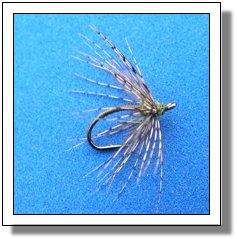
There is beauty in simplicity and the traditional soft-hackle wet fly is quite simply, beautiful. In its bareness, in the liveliness of its soft hackle fibers it suggests all that seems necessary to tempt fish. Because of its simplicity it's also one of the easiest flies to tie—and often one of the deadliest.
Also called a Hackle Fly, North Country Fly, Stewart Spider, or Yorkshire Spider, these flies were first mentioned in Dame Juliana Berners' 1496 Treatise of Fishing with an Angle. Likely their history extends even farther back than that. But it wasn't until Sylvester Nemes' 1975 The Soft-Hackled Fly that they began to receive the attention they deserve in the United States, and became known in general as "soft-hackle" flies. (Incidentally, The Soft Hackled Fly was updated in 2006 as The Soft-Hackled Fly and Tiny Soft Hackles; I highly recommend both the original book and the update for their history, fly patterns, and ideas.)
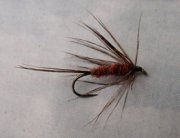 The
most basic version of the soft-hackle fly consists of a hook shank wrapped
with thread, floss, or peacock herl and a hackle (partridge, grouse,
hen or some other soft-hackled bird) wound around the forward part of
the shank. Here the hackle suggests the legs or emergent wings of various
insects such as caddis or mayflies. Slightly more elaborate versions
include a small thorax of dubbed fur just behind the hackle. Others —often
more specifically imitative of a mayfly nymph—will sport a tail
and perhaps a body of dubbed fur, in which case the fly is often referred
to as a soft-hackle nymph or "flymph," a type popularized by Leisenring
and Hidy. However you tie it, the soft hackle
wet fly deserves an honored place in your fly box.
The
most basic version of the soft-hackle fly consists of a hook shank wrapped
with thread, floss, or peacock herl and a hackle (partridge, grouse,
hen or some other soft-hackled bird) wound around the forward part of
the shank. Here the hackle suggests the legs or emergent wings of various
insects such as caddis or mayflies. Slightly more elaborate versions
include a small thorax of dubbed fur just behind the hackle. Others —often
more specifically imitative of a mayfly nymph—will sport a tail
and perhaps a body of dubbed fur, in which case the fly is often referred
to as a soft-hackle nymph or "flymph," a type popularized by Leisenring
and Hidy. However you tie it, the soft hackle
wet fly deserves an honored place in your fly box.
I first began tying these flies as a teenager in the 1950s after reading an article by Ray Bergman in Outdoor Life magazine titled Basic Wet Flies for Trout Fishing. They weren't called "soft-hackle wet flies" back then, just "hackle flies." Among my favorites were the Gray Hackle and Peacock and the Orange Fish Hawk, both tied with soft grizzly hen hackle on a #12 or #14 hook. Both were well-suited to the small skills of a beginning tyer and fly fisherman. Another favorite—one not found in Bergman—was one I called a Gray Pigeon (or sometimes a Flipper Fly). This pattern was hackled with a soft iridescent gray-blue feather taken from the neck area of a common pigeon with a body of soft gray fur clipped from the stomach of my old cat Flipper (who also supplied me with the pigeon).
I caught a lot of trout on these patterns but somewhere along the way, as my fly-tying skills became more developed and my flyfishing more sophisticated, I became interested in flies that more exactly imitated the insects in the streams I fished, flies that demanded more skill in both tying and fishing. I began to fill my fly boxes with more complicated patterns, relegating simpler flies to boxes that I rarely looked into. Eventually they became forgotten flies, rusting away and eaten by moths
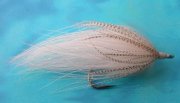 Then
in the mid-70s my interests began to shift back to simpler, more impressionistic
patterns; flies that suggested insects or baitfish in general, flies
tied with soft fibers that would move in the current like a living insect
or baitfish. It was at this time that I tied the first Sparrow and other
flies utilizing the soft aftershaft feathers found on a pheasant; also
the Soft Hackle Streamer which (when you look at it closely)
is simply a traditional soft hackle wet fly tied with a much longer
marabou hackle thus allowing it to suggest a baitfish. About this time
that I became friends with Sylvester Nemes, whose book rekindled my interest
in the traditional soft-hackle wet fly. Since then I always carry a selection
of traditional (and some not-so-traditional) soft-hackle wet flies with
me wherever I fish.
Then
in the mid-70s my interests began to shift back to simpler, more impressionistic
patterns; flies that suggested insects or baitfish in general, flies
tied with soft fibers that would move in the current like a living insect
or baitfish. It was at this time that I tied the first Sparrow and other
flies utilizing the soft aftershaft feathers found on a pheasant; also
the Soft Hackle Streamer which (when you look at it closely)
is simply a traditional soft hackle wet fly tied with a much longer
marabou hackle thus allowing it to suggest a baitfish. About this time
that I became friends with Sylvester Nemes, whose book rekindled my interest
in the traditional soft-hackle wet fly. Since then I always carry a selection
of traditional (and some not-so-traditional) soft-hackle wet flies with
me wherever I fish.
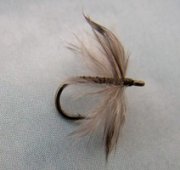 Following
the tying instructions given below I've listed some of my favorite soft-hackle
patterns. While most of them are tied with partridge feathers, you can tie a
whole range of soft-hackle wet flies using grouse, pheasant, woodcock,
snipe, starling, grackle, sparrow, common hen in various colors, and,
yes, even pigeon. For exceptionally soft-hackled flies, especially in
the smaller sizes (#16-20), you might also want to tie some using
the aftershaft feathers attached to the main body feathers of most of
these birds; these mostly dun-colored feathers are the softest of the
soft hackles and should not be overlooked by the tyer. They are very
effective, especially in slower-moving or still water, where they are
most productive. The ultra-soft and heavily-barbuled feathers found around
the anus of most
roosters and hens are also quite useful, especially grizzly; I refer to
this
feather often as a CPF (chicken-poop) feather throughout my web site.
Following
the tying instructions given below I've listed some of my favorite soft-hackle
patterns. While most of them are tied with partridge feathers, you can tie a
whole range of soft-hackle wet flies using grouse, pheasant, woodcock,
snipe, starling, grackle, sparrow, common hen in various colors, and,
yes, even pigeon. For exceptionally soft-hackled flies, especially in
the smaller sizes (#16-20), you might also want to tie some using
the aftershaft feathers attached to the main body feathers of most of
these birds; these mostly dun-colored feathers are the softest of the
soft hackles and should not be overlooked by the tyer. They are very
effective, especially in slower-moving or still water, where they are
most productive. The ultra-soft and heavily-barbuled feathers found around
the anus of most
roosters and hens are also quite useful, especially grizzly; I refer to
this
feather often as a CPF (chicken-poop) feather throughout my web site.
Hook Selection
The soft-hackle wet fly is usually tied on wet fly hooks (any shape, model, and size you like) because it is usually most effective fished just under the surface. You may, however, tie it on lighter-wire dry-fly hooks to fish it in the surface film, perhaps as a drowned nymph that didn't quite make it. A general rule for determining which hook to use is this: If you want the fly to imitate a caddis, tie it on a regular or short-shank hook without a tail; if you want it to imitate a mayfly, tie it on a regular or long-shank hook and add a tail.
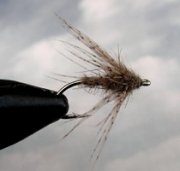 While
it's most often used for trout, soft-hackle wet fly is also a fine steelhead
and salmon fly, especially in heavily-fished waters or when the water
is low. For a deeper, faster-sinking fly, use a 2x heavy wire hook or
weight the fly with a copper wire or lead-wrapped body. Some anglers
even tie it with a bead-head. Its effectiveness is not limited to fresh
water either — it's a productive bonefish fly, especially in smaller
sizes (#8-#10).
While
it's most often used for trout, soft-hackle wet fly is also a fine steelhead
and salmon fly, especially in heavily-fished waters or when the water
is low. For a deeper, faster-sinking fly, use a 2x heavy wire hook or
weight the fly with a copper wire or lead-wrapped body. Some anglers
even tie it with a bead-head. Its effectiveness is not limited to fresh
water either — it's a productive bonefish fly, especially in smaller
sizes (#8-#10).
Fishing the Soft-Hackle Wet Fly
Probably the most common way to fish a soft-hackle wet fly is to cast it across and slightly downstream, letting it sink and then swing in the current, rising with the tightening line much as a natural rises to the surface before hatching. It's on this rise that fish usually strike. Another productive method is to cast the fly upstream on a short cast and then let it dead-drift back to you just under the surface (or, if tied on a light-wire hook, in the surface film). On lakes and ponds a soft hackle fly cast in front of a cruising trout and then twitched slightly can be absolutely deadly. Many soft-hackle fly anglers, especially in Europe, favor fishing two or three of these flies (of different colors and sizes) at a time.
And now it's time to tie.
Tying the The Partridge & Olive
| Hook: |
Daiichi 1150, 1550, Mustad 8100BR, Tiemco 3769, or any hook that you prefer, sizes 10-18 |
| Thread: |
6/0 Olive or size A flat nylon |
| Body: |
Olive thread or size A flat nylon |
| Ribbing: |
Gold wire, optional |
| Thorax: |
Hare's Ear or gray squirrel blend |
| Hackle: |
Hungarian Partridge |
| Head: |
Hare's Ear or gray squirrel blend |
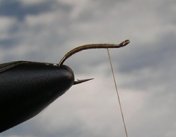 Wrap thread from just behind head to slightly around the bend of the hook and then back over the shank to a point approximately 1/4 shank length back from the eye. If ribbing is used, tie it in at the bend of the hook and then wind thread forward, trimming the excess at the point where you wind on your thorax.
Wrap thread from just behind head to slightly around the bend of the hook and then back over the shank to a point approximately 1/4 shank length back from the eye. If ribbing is used, tie it in at the bend of the hook and then wind thread forward, trimming the excess at the point where you wind on your thorax.
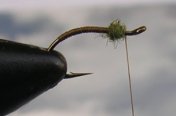 Dub onto thread a small amount of fur and wind over shank to form a thorax.
Dub onto thread a small amount of fur and wind over shank to form a thorax.
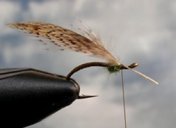 Strip downy fibers from stem and tie in partridge feather (concave side down) on top of hook shank and trim excess. Length of hackle may vary from long to short (your choice) but I prefer the tips on most flies to extend slightly beyond the bend of the hook.
Strip downy fibers from stem and tie in partridge feather (concave side down) on top of hook shank and trim excess. Length of hackle may vary from long to short (your choice) but I prefer the tips on most flies to extend slightly beyond the bend of the hook.
If you want a "fluffier," softer-hackled fly, strip the feather stem so that some of the downier barbs remain and are tied in with the first turn of the feather. Also, do not discard the aftershaft feather this is an exceptionally useful feather for tying smaller soft-hackle flies such as the Aftershaft Soft-Hackle Wet Fly
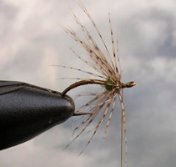 Wind partridge feather around hook (one turn or at most, two--the fly is best dressed sparsely.) Trim excess and form neat thread head.
Wind partridge feather around hook (one turn or at most, two--the fly is best dressed sparsely.) Trim excess and form neat thread head.
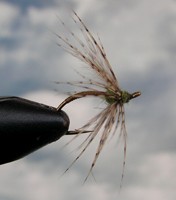 This step may be omitted but it's how I prefer to tie many of my soft-hackle flies, with a small amount of dubbing tightly wrapped just in front of the hackle to form a small head. Makes the fly look "buggier," I think.
This step may be omitted but it's how I prefer to tie many of my soft-hackle flies, with a small amount of dubbing tightly wrapped just in front of the hackle to form a small head. Makes the fly look "buggier," I think.
Soft Hackle Wets
Here are some of my favorite soft-hackle wet flies that you might want to tie up and try next time you're on the stream. All are tied in the manner described above.
The Partridge & Chartreuse
Hook: | Daiichi 1150, 1550, Mustad 8100BR, Tiemco 3769, or any hook that you prefer, #12-16 |
Thread: | 6/0 fluorescent chartreuse or size A flat nylon |
Body: | Fluorescent chartreuse thread or floss or size A flat nylon |
Ribbing: | Gold wire, optional |
Thorax: | Hare's Ear or gray squirrel blend |
Hackle: | Hungarian Partridge |
Head: | Fluorescent chartreuse thread or dubbed hare's ear or gray squirrel |
The Partridge & Orange
Hook: | Daiichi 1150, 1550, Mustad 8100BR, Tiemco 3769, or any hook that you prefer, #12-16 |
Thread: | 6/0 orange or size A flat nylon |
Body: | Orange thread or floss or size A flat nylon |
Ribbing: | Gold wire, optional |
Thorax: | Hare's Ear or gray squirrel blend |
Hackle: | Hungarian Partridge |
Head: | Orange thread or dubbed hare's ear or gray squirrel |
The Partridge & Yellow
Hook: | Daiichi 1150, 1550, Mustad 8100BR, Tiemco 3769, or any hook that you prefer, #12-16 |
Thread: | 6/0 yellow or size A flat nylon |
Body: | Yellow thread or floss or size A flat nylon |
Ribbing: | Gold wire, optional |
Thorax: | Hare's Ear or gray squirrel blend |
Hackle: | Hungarian Partridge |
Head: | Yellow thread or dubbed hare's ear or gray squirrel |
The Pheasant & Black
Hook: | Daiichi 1150, 1550, Mustad 8100BR, Tiemco 3769, or any hook that you prefer, #14, #16 |
Thread: | 6/0, black |
Body: | Black thread |
Ribbing: | Gold wire, optional |
Thorax: | Black fur dubbing |
Hackle: | Iridescent black ringneck pheasant feather taken from head or lower neck of pheasant |
Head: | Black fur dubbing or thread |
Brown Hackle, Peacock
Hook: | Daiichi 1150, 1550, Mustad 8100BR, Tiemco 3769, or any hook that you prefer, #14, #16 |
Thread: | 6/0, black |
Tag: | Gold wire, optional |
Body: | Peacock herl |
Ribbing: | Gold wire, optional |
Thorax: | None |
Hackle: | Brown mottled hen or grouse |
Head: | Black |
Aftershaft Soft Hackle Wet Fly
Hook: | Daiichi 1140, 1150, 1550,1640 Tiemco 2487, or any hook that you prefer, #14-20 |
Thread: | 6/0, olive, orange, yellow, black, rust |
Tag: | Gold wire, optional |
Body: | Olive, orange, yellow, black, or rust thread |
Ribbing: | Gold wire, optional |
Thorax: | None |
Hackle: | Aftershaft feather from partridge, pheasant (hen or cock), grouse |
Head: | Olive, orange, yellow, black, or rust thread |
Soft Hackle Nymphs
These flies differ from the above soft-hackle wet flies in that they're most often tied on a 1xl or 2xl hook, with a tail and with a body and thorax of fur, to imitate an emerging mayfly nymph. To imitate a caddis, simply tie the same fly on a regular or a shorter-shanked hook and omit the tail. These patterns may be varied, of course, to match more closely the sizes and colors of insects found on your local waters.
Partridge & Hare's Ear
Hook: | Daiichi 1710, 1280, 1640, Mustad 9671, TMC 3769, 5262 or any hook that you prefer, #14, #16 |
Thread: | 6/0 olive |
Body: | Olive thread |
Ribbing: | Gold wire, optional |
Thorax: | Hare's Ear or gray squirrel blend |
Hackle: | Hungarian Partridge |
Head: | Olive thread or dubbed hare's ear or gray squirrel |
Partridge & Muskrat
Hook: | Daiichi 1710, 1280, 1640, Mustad 9671, TMC 3769, 5262 or any hook that you prefer, #12-16 |
Thread: | 6/0 gray |
Tail: | Partridge |
Body: | Blue-dun gray muskrat body fur |
Ribbing: | Gold wire, optional |
Thorax: | Blue-dun gray muskrat body fur |
Hackle: | Hungarian Partridge |
Head: | Gray thread or blue-dun gray muskrat body fur |
Partridge & Red Squirrel (Hendrickson Nymph)
Hook: | Daiichi 1710, 1280, 1640, Mustad 9671, TMC 3769, 5262 or any hook that you prefer, #12-16 |
Thread: | 6/0 rust or brown |
Tail: | Pheasant tail fibers or wood duck |
Body: | Red squirrel fur (from the back of the squirrel, to include predominantly rust-red hairs) |
Ribbing: | Gold wire, optional |
Thorax: | Red squirrel fur |
Hackle: | Hungarian Partridge |
Head: | Rust or brown thread or dubbed red squirrel fur |
Soft Hackle March Brown Nymph
Hook: | Daiichi 1710, 1280, 1640, Mustad 9671, TMC 3769, 5262 or any hook that you prefer, #12, 14 |
Thread: | 6/0 rust or brown |
Tail: | Pheasant tail fibers |
Body: | Red squirrel fur mixed with amber fur dubbing |
Ribbing: | Gold wire, optional |
Thorax: | Red squirrel fur mixed with amber fur dubbing |
Hackle: | Hungarian Partridge |
Head: | Rust or brown thread or red squirrel fur mixed with amber fur dubbing |
Soft Hackle Pheasant Tail Nymph
Hook: | Daiichi 1710, 1280, 1640, Mustad 9671, TMC 3769, 5262 or any hook that you prefer, #14, #16 |
Thread: | 6/0 rust or brown |
Tail: | Pheasant tail fibers (three or four) |
Body: | Pheasant tail fibers wound over hook shank |
Ribbing: | Gold wire, optional |
Thorax: | Hare's Ear or gray squirrel blend |
Hackle: | Hungarian Partridge |
Head: | Rust or brown thread or dubbed hare's ear or gray squirrel |






